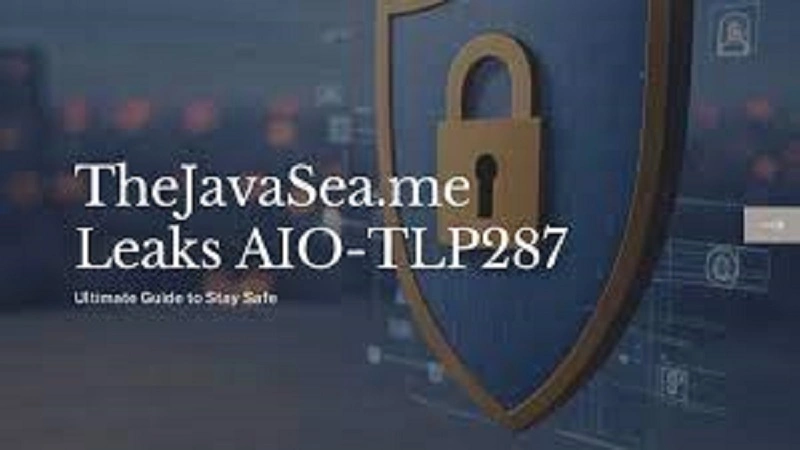
In the digital age, where most of our lives are online, data leaks and security breaches have become a common problem. Every year, thousands of websites face hacking attempts that expose personal or business data to the public. One of the latest discussions circulating on the internet revolves around thejavasea.me leaks aio-tlp370 — a name that has gained attention for being linked to leaked data and online privacy concerns.
But what does thejavasea.me leaks aio-tlp370 really mean? How does it affect people or organizations, and most importantly, how can you protect yourself from similar leaks?
In this detailed guide, we’ll break down everything you need to know in simple words. We’ll explain what leaks are, how they happen, how to check if your data is affected, and what steps to take for your online safety. Let’s get started.
What Are Data Leaks and Why Do They Happen?
A data leak means private information has been shared or exposed publicly without permission. This data might include things like usernames, passwords, emails, bank information, or other personal files.
Data leaks can happen in many ways:
-
Weak Passwords: Using simple or repeated passwords makes it easier for hackers to guess them.
-
Website Vulnerabilities: Outdated or poorly protected websites can be exploited.
-
Phishing Attacks: Users can be tricked into revealing sensitive information.
-
Third-Party Breaches: Even if your company is safe, a vendor’s leak can expose your information.
The term thejavasea.me leaks aio-tlp370 likely refers to a dataset or batch of leaked information that appeared online through an unknown source. Such leaks can spread across hacker forums, file-sharing sites, or social media platforms.
Understanding thejavasea.me leaks aio-tlp370
The keyword thejavasea.me leaks aio-tlp370 seems to describe a specific leak event or archive linked with a site or service named thejavasea.me. The term aio-tlp370 may refer to an internal tag, dataset ID, or code representing that collection of leaked files.
When such leaks appear online, they can contain:
-
User credentials (emails, passwords)
-
Payment details
-
Private company data
-
User communication logs
-
System or application files
Even if you’re not directly connected to the javasea.me, your data might still appear in thejavasea.me leaks aio-tlp370 if you used a related service or shared credentials on a linked platform.
It’s important to understand that just because a leak has been mentioned online doesn’t mean it’s verified. Some “leak” claims are exaggerated or fake, while others are real and serious. Therefore, checking the authenticity before panicking is always the right move.
Why thejavasea.me leaks aio-tlp370 Matters
You might think, “Why should I care about some random leak?”
The reality is — leaks don’t just affect one person or company. They can have a chain reaction of risks:
-
Identity Theft: Hackers can use leaked data to pretend to be you.
-
Financial Loss: If bank details are exposed, your money could be at risk.
-
Privacy Invasion: Leaked personal chats, photos, or files can cause embarrassment or blackmail.
-
Business Damage: Companies lose customer trust, face fines, and experience downtime.
-
Phishing Scams: Leaked email lists are used to send fake “security” alerts or infected links.
In short, thejavasea.me leaks aio-tlp370 matters because it highlights the growing issue of weak digital security and how easily private data can fall into the wrong hands.
How to Know If You Are Affected
If you suspect that your data might be part of thejavasea.me leaks aio-tlp370, here’s what you can do safely:
Step 1: Use Reliable Leak-Check Tools
Websites like HaveIBeenPwned.com allow you to enter your email and see if it appears in any known leaks. These tools are safe and widely trusted.
Step 2: Check Your Email Security Alerts
Most major email services (like Gmail, Outlook, and Yahoo) now alert users when their data is found in a breach. Check your spam and security folders for any recent alerts.
Step 3: Watch for Unusual Account Activity
If you notice new devices, strange logins, or password reset emails you didn’t request, your account might have been accessed by someone else.
Step 4: Check Forums or News Sources
Sometimes, leak-related discussions appear on Reddit or cybersecurity blogs. You can read updates there — but never download files or visit suspicious links.
Step 5: Contact the Affected Service
If you know you used thejavasea.me or any related service, contact their official support or help center for clarification.
What to Do If You Are Part of the Leak
Discovering your information in thejavasea.me leaks aio-tlp370 can feel scary, but you can limit the damage quickly by following these easy steps:
-
Change All Passwords Immediately.
Use a strong, unique password for every account. A password manager can help generate and remember them. -
Turn On Two-Factor Authentication (2FA).
This adds a second layer of protection. Even if your password leaks, hackers won’t access your account without the second code. -
Secure Your Email First.
Your email is the “master key” to all other accounts. Protect it with strong security measures first. -
Review Your Linked Accounts.
Disconnect any unknown apps or devices connected to your accounts. -
Monitor Financial Transactions.
Keep an eye on your credit or bank accounts for unusual activities. -
Warn Your Contacts.
If hackers might impersonate you, inform your close contacts not to trust strange messages from your accounts.
How Businesses Should Respond to Leaks
If you run a website or company that might be related to thejavasea.me leaks aio-tlp370, your response must be quick and transparent. Here’s how to handle it:
-
Activate Incident Response Plans:
Form a security team immediately to investigate the scope of the leak. -
Contain the Leak:
Shut down affected systems, reset passwords, and revoke compromised access tokens. -
Communicate with Users:
Be honest. Inform your users about what happened, what you’re doing to fix it, and how they can protect themselves. -
Work with Cybersecurity Experts:
Professionals can trace the leak source and close security holes. -
Notify Authorities:
Depending on your region, data privacy laws (like GDPR or local IT laws) may require formal reporting. -
Implement Preventive Measures:
After resolving the issue, strengthen your cybersecurity — update firewalls, encrypt sensitive files, and schedule security audits.
How to Protect Yourself from Future Leaks
While you can’t stop all leaks, you can reduce your risk with some simple habits:
-
Use Strong Passwords: Avoid names, birthdays, or repeated words. Combine letters, numbers, and symbols.
-
Don’t Reuse Passwords: Every account should have its own password.
-
Use a Password Manager: Tools like Bitwarden or LastPass help store and manage passwords safely.
-
Enable 2FA Everywhere: It’s one of the best defenses against hackers.
-
Keep Software Updated: Always install the latest updates for apps and systems.
-
Avoid Suspicious Links: Phishing emails often look real. Double-check before clicking.
-
Backup Important Data: Keep encrypted backups of your essential files.
-
Educate Yourself and Your Team: If you run a business, train your employees about data safety.
Cybersecurity is not just for experts — it’s something everyone can learn with practice.
The Legal and Ethical Side of Leaks
When leaks like thejavasea.me leaks aio-tlp370 happen, it’s important to remember that:
-
Downloading, sharing, or spreading leaked data is illegal in most countries.
-
Ethical handling means reporting it to the affected organization or authorities, not exposing more people.
-
Cyber laws are becoming stricter — mishandling leaked data can result in heavy fines or imprisonment.
Always choose responsible action. Being curious is natural, but participating in or spreading leaks causes real harm to innocent people.
The Role of Cybersecurity in Modern Life
Events like thejavasea.me leaks aio-tlp370 highlight one truth — cybersecurity is no longer optional.
Every person, from students to CEOs, relies on digital systems. Protecting your information is as important as locking your home.
Here’s how cybersecurity benefits everyone:
-
For Individuals: Keeps personal life, money, and identity safe.
-
For Businesses: Protects customer trust and ensures compliance with regulations.
-
For Society: Reduces cybercrime and builds a safer online environment.
Even small steps, like updating passwords and enabling 2FA, make a huge difference.
Final Thoughts on thejavasea.me leaks aio-tlp370
The case of thejavasea.me leaks aio-tlp370 is another reminder that digital security requires constant care. Whether the leak is real or rumored, it shows how fragile our online data can be. The key to safety lies in awareness, quick action, and prevention.
Remember:
-
Always stay informed about cybersecurity news.
-
Use trusted tools to check if your data appears in leaks.
-
Never share or open suspicious links claiming to show leaked information.
-
Protect your personal and business accounts with layers of security.
Leaks will continue to happen, but being informed and prepared can help you stay safe and confident in the digital world.
Summary
| Step | What to Do | Why It Matters |
|---|---|---|
| 1 | Check if you’re in the leak | To know your risk level |
| 2 | Change passwords & use 2FA | Prevent future access |
| 3 | Monitor your email & bank accounts | Detect suspicious activity |
| 4 | Stay updated with security news | Awareness is protection |
| 5 | Educate yourself & your team | Build a culture of safety |
Conclusion
In simple words, thejavasea.me leaks aio-tlp370 is a signal to be cautious, alert, and proactive. Don’t panic if you hear about leaks; instead, take smart steps to protect your digital life.
Online safety is not complicated — it’s just about small, consistent actions. By following the tips in this guide, you can keep your information secure and stay ahead of potential cyber threats.
SEE MORE: homestylish.org






